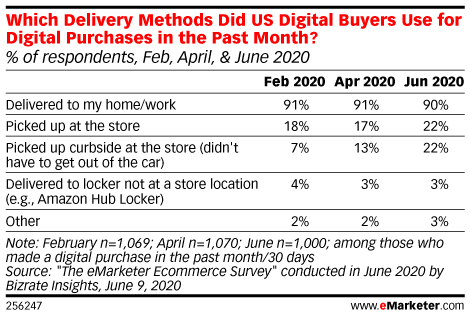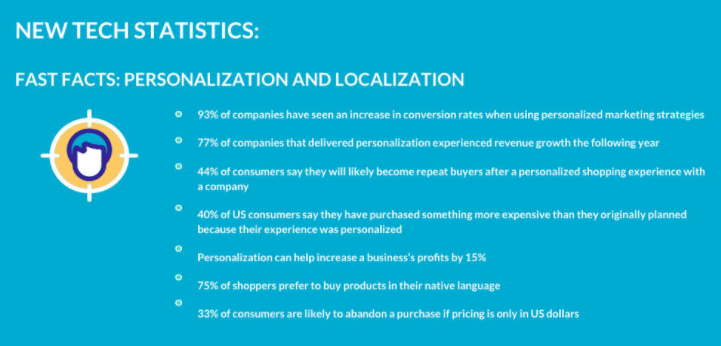Everything You Need to Know About Ecommerce and Ecommerce Marketing
While this year might have been tough for many of us, ecommerce can’t relate. Keep reading to learn more about ecommerce and ecommerce marketing after its most successful year ever. Plus, see how you can create the best digital storefront possible -- no matter how big or small your business is.
Here’s a recap of what we’ll be discussing:
- What is Ecommerce?
- Ecommerce: A Year in Review
- How to Get Started with Ecommerce
- Consumers Want a Human Experience
- What are the Best Platforms to Use for Ecommerce Marketing?
- Search Engine Marketing
- Email Marketing
- Multichannel Marketing
- How to Get Started with Digital Marketing
Questions or comments?
Contact us!
What is Ecommerce?
Many people automatically think of Amazon and the biggest household names in the industry when they think of ecommerce, however, the term simply refers to any transaction of products or services that takes place online.
You don’t need to be Jeff Bezos in order to build out your very own ecommerce business -- small businesses of all kinds can (and should) get in on the action too. Not convinced yet? Time to review the monumental year ecommerce has had.
Ecommerce: A Year in Review
U.S. ecommerce has grown more than 30% in 2020 alone, accelerating the already rapid online shopping shift by two years, according to eMarketer. Largely due to the pandemic and looming safety concerns, shoppers everywhere have realized that they can also save time thanks to this convenient method.
From takeout dinners to grocery shopping, ecommerce has taken practically every industry by storm -- and consumers aren’t planning on leaving it behind once the pandemic improves. One
survey
found that of the consumers who began ordering groceries online during the COVID-19 pandemic, 75.8% will continue to do so after the crisis, and 80% of them are ordering more than they did pre-pandemic.
It’s clear that safety and convenience is of utmost importance, which transcends age groups. While younger audiences were known to be the primary demographics who would shop and order online, the pandemic has persuaded people of all ages to give it a try -- meaning that ecommerce has surged partly thanks to its more recent older converts who weren’t previously comfortable using it.
Curbside pickup options have also skyrocketed, since it offers a happy medium for consumers who don’t want to shop in-store and who don’t want to pay extra delivery fees. For instance, a July 2020 research study from CommerceNext and CassarCo Strategy and Analytics found that
43%
of internet users within the U.S. said that they used curbside pickup for the first time during the pandemic.
Want more marketing insights based off of what we’ve learned from 2020?
Read our post.
How to Get Started with Ecommerce
Consumers flock to online shopping for its ease and convenience, plus the added bonus of safety and social distancing. Making your business’ website as easy to use as possible will ensure a positive user experience and make things easier for everyone involved.
Above all,
78%
of mainstream consumers say it is most important for a website or app to be fast and easy to navigate. While you might think flashy animations look great, anything that creates a longer page load time can deter users from staying on your site. The same goes for the online shopping checkout process as well, with
83%
of mainstream consumers wanting a checkout process that’s quick and easy.
Plus, don’t forget to be inclusive by offering a Spanish version of your offerings, especially if your area has a large Spanish-speaking Latino population. Learn more about reaching growing Latino audiences by
reading our article on the importance of Hispanic digital marketing and multicultural marketing.
With major changes to their everyday lives, consumers also have major expectations for their online experiences. A
survey
conducted by Experian in September of 2020 found that:
- 60% of consumers worldwide have higher expectations for their digital experience than they did prior to COVID-19.
- One third of shoppers will abandon their online shopping carts within 30 seconds, especially once they access their financial accounts
- 70% of firms are focusing on fraud prevention over revenue generation to protect their online transactions.
Given these higher expectations, what exactly does a seamless experience look like? For one, optimizing your website's design across desktop, mobile, and tablet formats is essential. Next, you should focus on tackling or preventing the most common issues users have with the online shopping experience.
For instance, online shopping cart abandonment and fraud tend to be the biggest pain points among both brands and consumers alike. Make your site easy to navigate by hiring experts and choosing an ecommerce solutions platform.This will ensure that your web design and user experience is up to par, while also optimizing for the latest online shopping features.
Don’t forget to keep safety in mind as well by making sure measures are in place for secure transactions. Plus, stay on top of shipping options, costs, and delays, which also play a big role in cart abandonment.
Consumers Want a Human Experience
Whether they’re online shopping or not, shoppers want to feel like they’re interacting with a human, not just a website interface. It might sound counterintuitive to make online shopping feel more like in-store shopping, but consumers want the best of both worlds.
Offering alternatives like video chat or chatbots to communicate in real time is an added step that can make a huge difference. Plus, access to customer reviews and FAQs can provide an extra boost by making people feel at ease throughout their shopping experience.
Experiences that feel more personal and human can also increase loyalty. For instance, recommending certain products or services based on previous purchases or offering a loyalty program with special promotions can make shoppers feel taken care of -- which will make them want to return.
What are the Best Ecommerce Marketing Platforms?
Many businesses offer ecommerce options these days, so how can you make sure your online business gets the attention it needs? We’ve got you covered. Check out our top suggestions below!
Search Engine Marketing
Ecommerce wouldn’t exist without online search. That being said, staying on top of search trends and optimizing your paid search strategy is crucial. Pay close attention to mobile search as well, which has seen a major spike in popularity as people are increasingly searching while they’re on-the-go and looking for products and services near them.
Google’s 2020 retail holiday guide
findings
show that:
- Searches for “curbside pickup” are up 3,000% year-over-year.
- Searches for “click + collect” are up 600% globally.
- Year-over-year, 61% of U.S. shoppers feel that in-store or curbside pickup is an advantageous way for them to shop, even after all restrictions come to an end.
Facebook’s holiday insights
report
for 2020 echoes similar sentiments, stating:
- Online shopping trends will continue over the holiday season with 43% of people surveyed saying they expect to shop online more frequently after the outbreak is over.
- Among those surveyed, an average 72% of Gen X and 50 percent of Boomers say they’re spending more time on mobile during the COVID-19 outbreak.
- While digital adoption had already been growing, the COVID-19 outbreak has accelerated this trend, particularly encouraging older generations to embrace Ecommerce.
- Of the surveyed Gen X and Boomers who shop online, on average 44% and 30% respectively said they are spending more time shopping online.
For an in-depth look into search engine marketing and its benefits, be sure to
check out our article.
Email Marketing
Over half (59%) of consumers say that email marketing influences their purchasing decisions, making email marketing a perfect way to inform both new and existing customers about the latest sales and inventory changes taking place at your business.
Whether you’re a legal firm offering new online consultations or a grocery store wanting to send out a flyer of weekly specials or delivery options, email is a simple yet effective way of delivering your message.
Because email is so widely used, you may be wondering how you can make your business’ marketing emails stand out. Think about it, would you be more interested in a generic email or one that reads as if it’s tailored to you and your interests?
According to one research study, personalized emails can produce a transaction rate of
6x higher
than those of other marketing emails -- email is the place to keep things personal! The best way to do so is through email automation technology, which can track performance and allow for customization tailored to your target audience.
If you’re not sure how to get started on your own, take a look at our
email marketing offerings or
contact us for more info.
Multichannel Marketing
Multichannel marketing refers to marketing campaigns that utilize multiple platforms at once. At the most basic level, multichannel marketing can allow your business to reach and engage with more people by addressing them across several platforms.
That being said, 360 campaigns can offer a more holistic approach by addressing users and their needs at varying stages of the purchase funnel. From building awareness, generating leads, or converting customers, every digital platform serves its own unique purpose at different phases of the purchase journey.
If you’re looking to take things to the next level, you can consider retargeting options, which allow your business to engage with the same consumers on several platforms to stay top of mind.
360 campaigns can also provide key insights into which platforms perform the best for your ads -- so you can optimize for future campaigns accordingly. When it comes to digital marketing, the more platforms the merrier! See some of the stats below for more info.
Want to see case studies from businesses who have leveraged real results from 360 marketing campaigns? Visit our success stories page.
How to Get Started with Digital Marketing
These days, staying up to date with the latest consumer insights and preferences is make or break. There’s a lot to consider when building your online presence and digital marketing strategy, but you shouldn’t have to go it alone.
Whether you’re looking for expert web design, digital marketing planning, strategy, or execution, we have the solutions you've been looking for. Feel free to
contact
one of our expert digital marketing consultants or find a
location near you
for more information.
General questions? We’re happy to answer those too --
contact us!

















